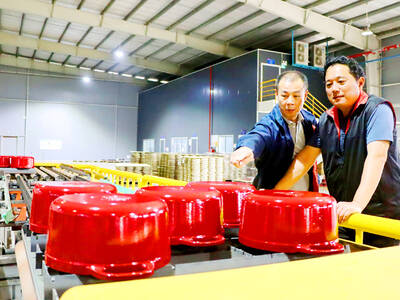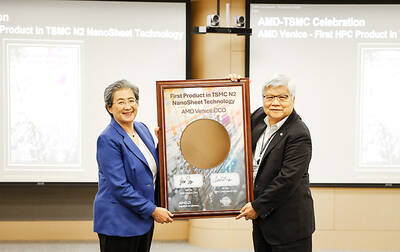The world’s biggest developer of offshore wind farms is weighing nearly US$13 billion of projects in Taiwan, saying that the COVID-19 pandemic has not shifted its optimism about the region.
The potential investments by Orsted A/S would include the Greater Changhua 3 wind farm, which it plans to bid for in the next round of auctions if the conditions are “manageable,” Orsted president for Asia-Pacific Matthias Bausenwein said in a telephone interview.
The auction is scheduled for the end of this year, and the company would wait to see the framework and rules for the contest before deciding whether to participate.
Orsted has already built and commissioned Formosa 1 (海洋風電), the first commercial-scale offshore wind farm in Taiwan, with joint venture partners. It is also building the Greater Changhua 1 and 2a wind farms, which are estimated to be completed next year or in 2022. Another plan is to build the Greater Changhua 2b and 4 wind farms in 2025.
Total capital expenditure for all four projects, with a capacity of 2.4 gigawatts, is estimated at up to NT$380 billion (US$12.5 billion).
“At the moment, we don’t see the coronavirus changing any of our plan,” Bausenwein said. “Business is as usual. We aim to be a long-term player in Taiwan.”
Orsted on Wednesday said that it is sticking to its guidance for this year, despite the coronavirus, and that its liquidity position is strong.
Funding for the investment would be from Orsted’s own capital and financing from Taiwan’s local financial institutions, as well as bond market, backed by an Orsted parent company guarantee.
The company has issued its first batch of NT$12 billion green bonds in Taiwan, and it might go ahead with another.
In addition to Taiwan, Japan is the next big step for Orsted in the Asia-Pacific region. The company has formed a joint venture with Tokyo Electric Power Co to prepare a bid for an auction at the end of this year.
Taiwan and Japan are both mountainous and rely heavily on fossil fuel imports, with highly populated coastal areas that make offshore wind an ideal renewable energy source.
Taiwan aims to be a leading developer of green energy. It has targeted 5.7 gigawatts of offshore wind power by 2025 and another 10 gigawatts by 2035.
BloombergNEF expects Japan’s offshore wind capacity to exceed 9 gigawatts by 2030.
“Taiwan is a lively market with diversity of players, both local and global ones,” Bausenwein said. “We are well-positioned for any future auction with our commitment and what we have delivered.”

TAKING STOCK: A Taiwanese cookware firm in Vietnam urged customers to assess inventory or place orders early so shipments can reach the US while tariffs are paused Taiwanese businesses in Vietnam are exploring alternatives after the White House imposed a 46 percent import duty on Vietnamese goods, following US President Donald Trump’s announcement of “reciprocal” tariffs on the US’ trading partners. Lo Shih-liang (羅世良), chairman of Brico Industry Co (裕茂工業), a Taiwanese company that manufactures cast iron cookware and stove components in Vietnam, said that more than 40 percent of his business was tied to the US market, describing the constant US policy shifts as an emotional roller coaster. “I work during the day and stay up all night watching the news. I’ve been following US news until 3am

UNCERTAINTY: Innolux activated a stringent supply chain management mechanism, as it did during the COVID-19 pandemic, to ensure optimal inventory levels for customers Flat-panel display makers AUO Corp (友達) and Innolux Corp (群創) yesterday said that about 12 to 20 percent of their display business is at risk of potential US tariffs and that they would relocate production or shipment destinations to mitigate the levies’ effects. US tariffs would have a direct impact of US$200 million on AUO’s revenue, company chairman Paul Peng (彭雙浪) told reporters on the sidelines of the Touch Taiwan trade show in Taipei yesterday. That would make up about 12 percent of the company’s overall revenue. To cope with the tariff uncertainty, AUO plans to allocate its production to manufacturing facilities in

Six years ago, LVMH’s billionaire CEO Bernard Arnault and US President Donald Trump cut the blue ribbon on a factory in rural Texas that would make designer handbags for Louis Vuitton, one of the world’s best-known luxury brands. However, since the high-profile opening, the factory has faced a host of problems limiting production, 11 former Louis Vuitton employees said. The site has consistently ranked among the worst-performing for Louis Vuitton globally, “significantly” underperforming other facilities, said three former Louis Vuitton workers and a senior industry source, who cited internal rankings shared with staff. The plant’s problems — which have not

COLLABORATION: Given Taiwan’s key position in global supply chains, the US firm is discussing strategies with local partners and clients to deal with global uncertainties Advanced Micro Devices Inc (AMD) yesterday said it is meeting with local ecosystem partners, including Taiwan Semiconductor Manufacturing Co (TSMC, 台積電), to discuss strategies, including long-term manufacturing, to navigate uncertainties such as US tariffs, as Taiwan occupies an important position in global supply chains. AMD chief executive officer Lisa Su (蘇姿丰) told reporters that Taiwan is an important part of the chip designer’s ecosystem and she is discussing with partners and customers in Taiwan to forge strong collaborations on different areas during this critical period. AMD has just become the first artificial-intelligence (AI) server chip customer of TSMC to utilize its advanced